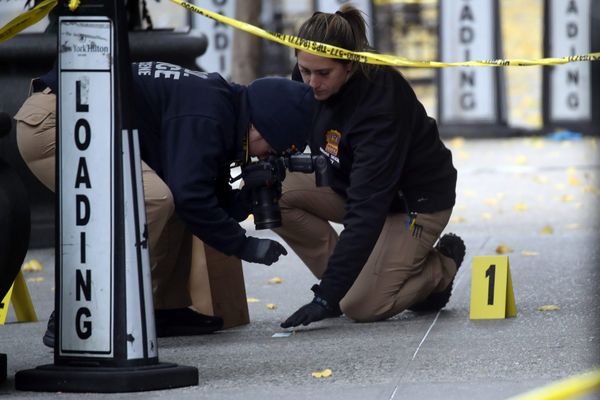
At first glance, if you squint, you might think it was a photograph: a couple nuzzling together in the front row of a concert hall, in a Facebook advertisement for the Queensland Symphony Orchestra (QSO).
But look again and you’ll see why it’s caused a stir among creative workers and the union representing them. The couple’s tangled fingers are both too large and too many; there’s a strange sheen making them look more like wax dolls; and then there’s the clothes: she in a tulle gown encrusted with jewels, he in a tuxedo – and, simultaneously, a tulle gown encrusted with jewels. Also: she has a large cube on her lap.
“Want to do something different this Saturday? Come see an orchestra play,” reads the ad. It was apparently created by someone who has never seen an orchestra play, and imagines it as rows of violinists seated in the audience, many playing with three hands or one hand or no hands at all.
The picture, shared by the QSO on 22 February, appears to be sourced from stock image aggregator Shutterstock, where it is listed under the AI prompt “two people having a date at a indoor classical music romantic concert”.
On Tuesday, industry union the Media, Entertainment & Arts Alliance (MEAA) called it “the worst AI generated artwork we’ve seen”.
“It is inappropriate, unprofessional and disrespectful to audiences and the musicians of the QSO,” they added. “Creative workers and audiences deserve better from arts organisations.”
The post also attracted criticism in its replies. “Next time pay photographers,” one comment reads. Another called it “terrible – literally an arts organisation not using artists.”
Classical music industry blog Slipped Disc was the first to report on the ad, claiming it had resulted in “uproar” and “fury” among the orchestra’s players.
Queensland Symphony Orchestra did not comment on that claim but justified their use of the AI image in a statement to Guardian Australia: “At QSO, we encourage exploration, innovation, experimentation and the adoption of new technologies across all facets of the business. From time to time we will use new marketing tools and techniques as we are an orchestra for all Queenslanders.”
Daniel Boud is a Sydney-based freelance photographer often employed by major performing arts companies for their promotional imagery and production shots. He said while he hasn’t noticed himself losing work yet to AI, “I’m getting more briefs now where the mock-ups are done by AI – so the design agency or a marketing person will use AI to visualise a concept, which is then presented to me to turn into a reality. That’s a reasonable use of AI because it’s not doing anyone out of a job.”
He called the QSO ad “poorly considered”.
“To me that should have been the mock-up for a real shoot – it’s a nice concept. But get real musicians in a real theatre.
“I’m also sympathetic. That shoot in real life would cost many thousands of dollars to turn it into reality.
“But the image they’ve used is awful, so it isn’t going to put photographers out of work. Although when the technology improves, I hope it won’t become the new norm.”
AI-generated imagery has stirred much debate and outrage since its rise in recent years due to the accessibility of consumer tools such as Dall-E and Midjourney. Much of the controversy revolves around AI’s potential to devalue or plagiarise human artists.
In the past 18 months, at least two art prizes have made headlines after their winners were found to have generated or altered their works with AI. “I’m not going to apologise for it,” said Jason M Allen, who took home an award for digital artists at the Colorado State Fair in 2022. “I won, and I didn’t break any rules.”
In 2023, German artist Boris Eldagsen won a prize at the Sony world photography awards for an AI-generated photograph of two women in black and white. He later admitted he had “applied as a cheeky monkey” in order to incite discourse around the ethics of AI – and refused to accept the award.
Last September, the Australian Financial Review accompanied its annual list of the country’s 10 most culturally powerful people with AI-generated images of its subjects.
“How quickly can you spot that they’re fakes?” the publication asked in an editorial justifying its decision at the time.
Given its bizarro output of a marionette-like Margot Robbie and a many-fingered Sam Kerr, the answer for many was: alarmingly quickly.
• This article was amended on 7 March 2024. An earlier version incorrectly stated that Boris Eldagsen refused to return an award; in fact, he refused to accept it.







